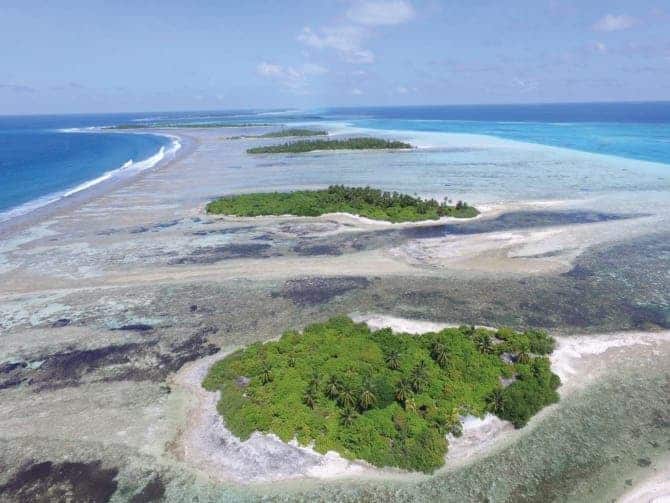There might be a silver lining to sea level rise — emphasis on ‘might’.

Image credits Prof. Paul Kench.
New research proposes that rising sea levels may help the long-term formation of coral reef islands, such as the Maldives. However, all the other bits of climate change may destroy any benefits it brings.
Climate change, island change
“Coral reef islands are typically believed to be highly vulnerable to rising sea levels. This is a major concern for coral reef island nations, in which reef islands provide the only habitable land,” says lead author Dr. Holly East of the Department of Geography and Environmental Sciences at Northumbria University, Newcastle.
Coral reef islands aren’t very keen on altitude; typically, they’re less than three meters (about 10 feet) above the water’s surface. This obviously makes them very vulnerable to rising sea levels. However, the same high seas might’ve also created the islands, the team reports.
The researchers studied five islands in the southern Maldives. By drilling out core samples, they were able to reconstruct when and how the islands formed. They report that storms off the coast of South Africa created a series of large waves (‘high-energy wave events’) that led to the formation of the Maldives. These violent waves dislodged large chunks of pre-existent reefs and transported them onto reef platforms. This stacking of reef material created the foundations of the islands we see today.
“We have found evidence that the Maldivian rim reef islands actually formed under higher sea levels than we have at present,” Dr. East adds.
“This gives us some optimism that if climate change causes rising sea levels and increases in the magnitude of high-energy wave events in the region, it may actually create the perfect conditions to reactivate the processes that built the reef islands in the first place, rather than drowning them.”
The seas were around 0.5 meters (1.5 feet) higher than today during the islands’ formations — this allowed the waves to carry more energy. Both the higher sea level and large wave events were critical to the construction of the islands. Now, (man-made) climate change is also pushing up sea levels; the team says that projected increases in both sea level and the magnitude of large wave events could actually lead to the growth of reef islands.
For that to happen, however, you need living, healthy coral in the region’s reef communities, Dr. East stresses. And we’re murdering them pretty fast right now.
“As these islands are mostly made from coral, a healthy coral reef is vital to provide the materials for island building. However, this could be problematic as corals face a range of threats under climate change, including increasing sea surface temperatures and ocean acidity,” she says.
“If the reef is unhealthy, we could end up with the perfect building conditions but not the bricks.”
She also cautioned that “the large wave events required for reef island building may devastate island infrastructure, potentially compromising the habitability of reef islands in their current form.” Factoring in higher sea levels as well, she says that reef island nations need to “develop infrastructure with the capacity to withstand, or be adaptable to, large wave events” — a task she summarizes as being a “challenge”.
Their paper, “Coral Reef Island Initiation and Development Under Higher Than Present Sea Levels,” has been published in the journal Geophysical Research Letters.


